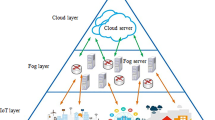Abstract
With the rapid development of healthcare, mobile cloud computing can improve medical efficiency by capturing and analyzing patient data. Fog computing, as an emerging paradigm to complement cloud computing, has significant advantages in local wireless signal processing, resource management and distributed storage capabilities to potentially meet future healthcare demands. However, performance is limited by the capacity of fronthaul links. In this paper, we propose a novel fog radio access network (F-RAN) model, where cooperation caching strategy and content transmission are jointly optimized. We formulate a mixed integer nonlinear programming problem in order to achieve an ultra-low delay for the proposed F-RAN. We also propose a novel matching algorithm based on the student project allocation (SPA) algorithm instead of the traditional optimization algorithm to solve the formulated problem. Numerical results reveal that the proposed joint optimization design can significantly improve the performance of the considered F-RAN.





Similar content being viewed by others
References
Stanley M (2011) The Mobile Internet report: Ramping faster than desktop Internet, the mobile Internet will be bigger than most think. Retrieved April 2, 2011 from http://www.morganstanley.com/institutional/techresearch/pdfs/Theme_6_Data_Growth.pdf
Shi YQ, Ma C (2012) The Characteristics of the Mobile SNS Social Behavior: A Case Study of College Students in Shanghia. Proceedings of the 19th International Conference on Management Science & Engineering, 129–134. Dallas: IEEE
Zhu R, Zhang X, Liu X, Shu W, Mao T, Jalaian B (2015) Erdt energy-efficient reliable decision transmission for intelligent cooperative spectrum sensing in industrial iot. IEEE Access 3:2366–2378
Gao H, Liu CH, Wang W et al (2015) A survey of incentive mechanisms for participatory sensing[J]. IEEE Commun Surv Tutorials 17(2):918–943
Liu W, Park E (2014) Big data as an e-health service. In Computing, Networking and Communications (ICNC), 2014 International Conference on(pp. 982–988). IEEE
Stantchev V, Colomo-Palacios R, Niedermayer M (2014, Apr) Cloud computing based systems for healthcare. Sci World J 2014:1–2
Zhang ZJ, Lai CF, Chao HC (2014) A green data transmission mechanism for wireless multimedia sensor networks using information fusion. IEEE Wirel Commun Mag 21(4):14–19
Zhang B, Liu CH, Tang J, Xu Z, Ma J, Wang W (2018) Learning-based energy-efficient data collection by unmanned vehicles in smart cities[J]. IEEE Trans Ind Inf 14(4):1666–1676
Fog Computing and the Internet of Things: Extend the Cloud to Where the Things are, San Jose, CA, USA:CISCO, 2015. [Online]. Available: https://www.cisco.com/c/dam/en_us/solutions/trends/iot/docs/computing-overview.pdf. Accessed 10 June 2018
Zhang K, Liang X, Ni J, Yang K, Shen X (2016) Exploiting social network to enhance human-to-human infection analysis without privacy leakage. IEEE Trans Dependable Secure Comput
Dsouza C, Ahn G-J, Taguinod M (2014) Policy-driven security management for fog computing: preliminary framework and a case study. Proc IEEE IRI, pp 16–23
Yi S et al (2015) Fog computing: platform and applications. Third IEEE workshop on hot topics in web systems and technologies IEEE computer society, pp 73–78
Zhou Y, Tang W, Zhang D, Lan X, Zhang Y (2017) A case for software-defined code scheduling based on transparent computing. Peer-to-Peer Networking and Applications, pp 1–11
Hsu H, Chen K-C (Jan. 2016) A resource allocation perspective on caching to achieve low latency. IEEE Commun Lett 20(1):145–148
Rodrigues TG, Suto K, Nishiyama H, Kato N (May 2017) Hybrid method forminimizing service delay in edge cloud computing through VM migration and transmission power control. IEEE Trans Comput 66(5):810–819
Zhang W, Zhang Z, Chao HC (2017) Cooperative fog computing for dealing with big data in the internet of vehicles: architecture and hierarchical resource management. IEEE Commun Mag 55(12):60–67
Aazam M, Huh E (2015) E-HAMC: leveraging fog computing for emergency alert service. IEEE international conference on pervasive computing and communication workshops, pp 518–523
Gu L, Zeng D, Guo S, Barnawi A, Xiang Y (2017) Cost efficient resource management in fog computing supported medical cyber-physical system. IEEE Trans Emerg Topics Comput 5(1):108–119
Dubey H et al (2016) Fog data: enhancing telehealth big data through fog computing In: Proceedings of the ASE BigData & SocialInformatics 2015, 14.. ACM
Chen Z, Lee J, Quek TQS, Kountouris M (2016) Cooperative caching and transmission design in cluster-centric small cell networks in, Jan. 2016, [online] Available: https://arxiv.org/abs/1601.00321
Shih Y-Y et al (2017) Enabling low-latency applications in fog-radio access networks. IEEE Netw 31(1):52–58
Bertsimas D, Tsitsiklis JN (1997) Introduction to linear optimization, volume 6 of Athena scientific series in optimization and neural computation. Athena Scientific
El-Atta AHA, Moussa MI (2009) Student project allocation withpreference lists over (student, project) pairs. In: Second international conference on computer and electrical engineering, Dubai, Dec 2009
Roth AE, Sotomayor MAO (1990) Two-sided matching: a study in game-theoretic modeling and analysis. Econometric Society Monographs. Cambridge University Press, New York
Acknowledgments
This work is supported by the Fundamental Research Funds for the Central Universities under Grant 2018YJS007, and National Natural Science Foundation of China under Grant 61772064, and Academic Discipline, Post-Graduate Education Project of the Beijing Municipal Commission of Education.
Author information
Authors and Affiliations
Corresponding author
Additional information
Publisher’s Note
Springer Nature remains neutral with regard to jurisdictional claims in published maps and institutional affiliations.
This article is part of the Topical Collection: Special issue on Fog Computing for Healthcare
Guest Editors: Han-Chieh Chao, Sana Ullah, Christos Verikoukis, and Ki-Il Kim
Rights and permissions
About this article
Cite this article
Tong, S., Liu, Y., Cho, HH. et al. Joint radio resource allocation in fog radio access network for healthcare. Peer-to-Peer Netw. Appl. 12, 1277–1288 (2019). https://doi.org/10.1007/s12083-018-0707-4
Received:
Accepted:
Published:
Issue Date:
DOI: https://doi.org/10.1007/s12083-018-0707-4




